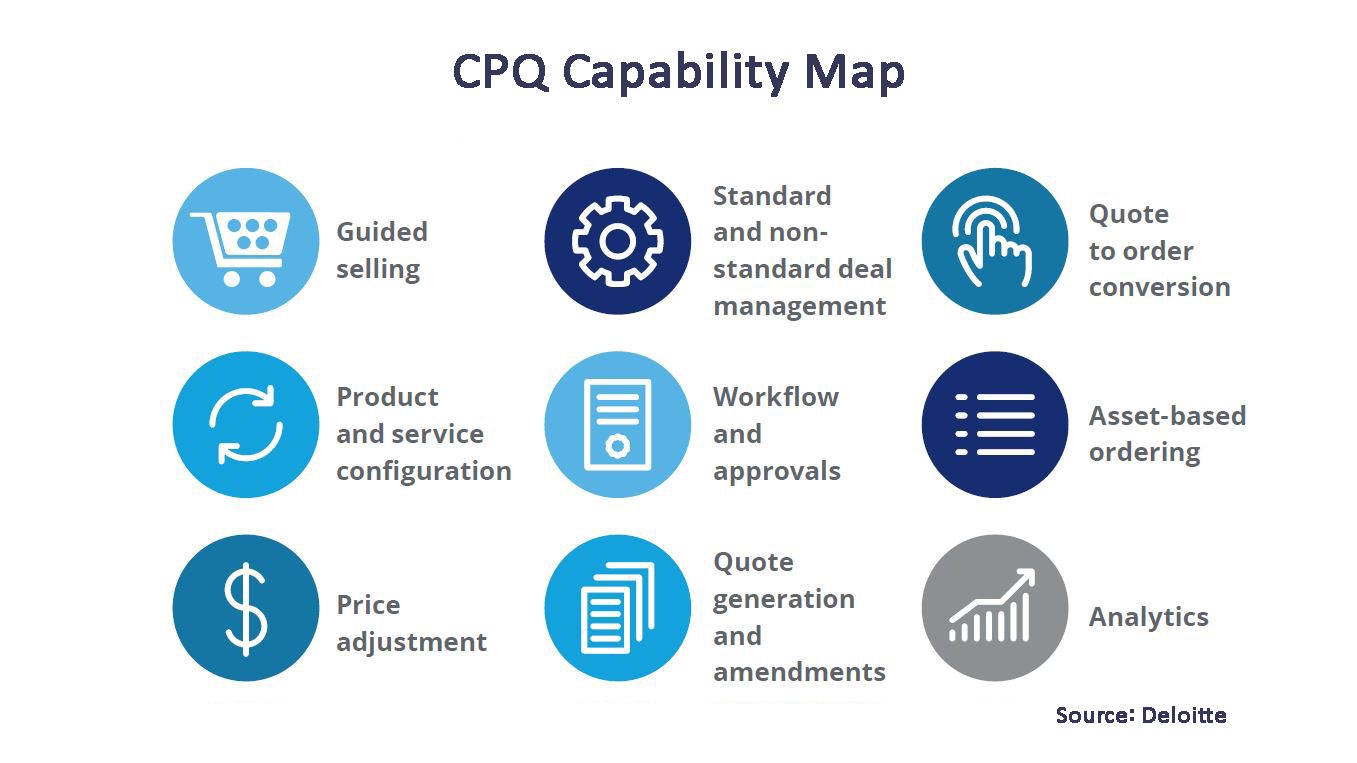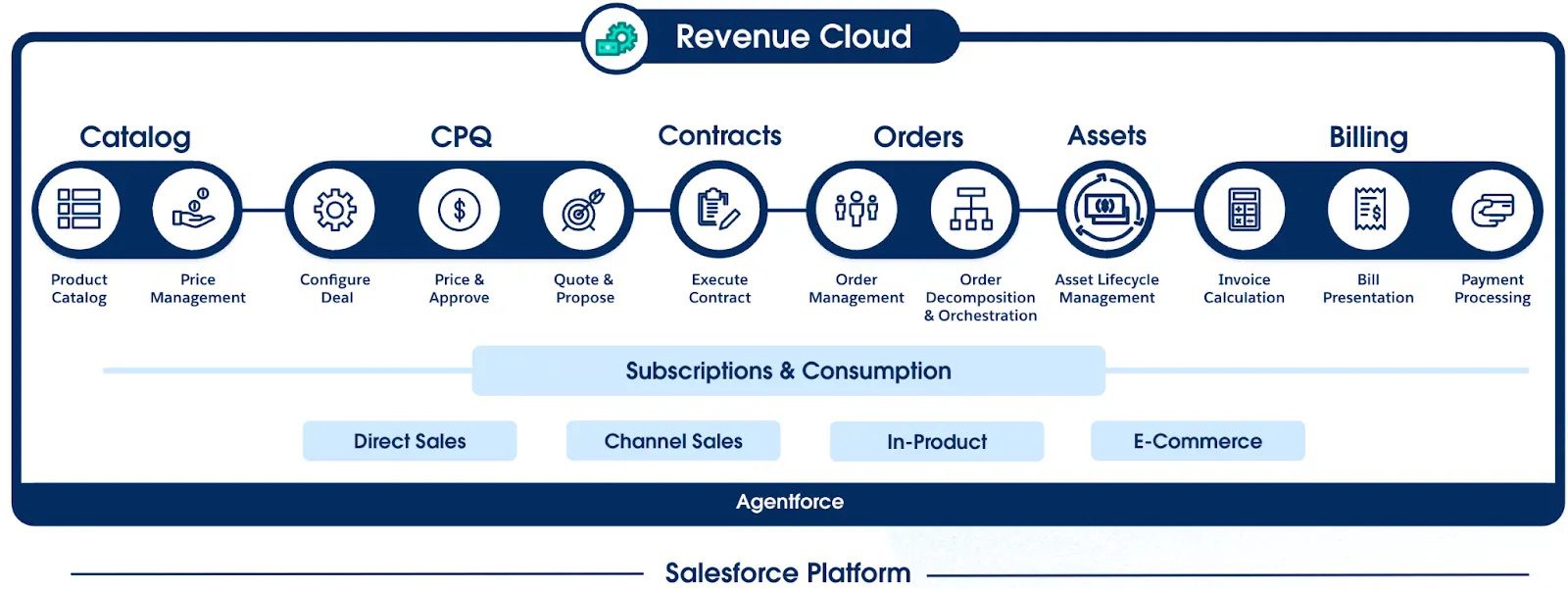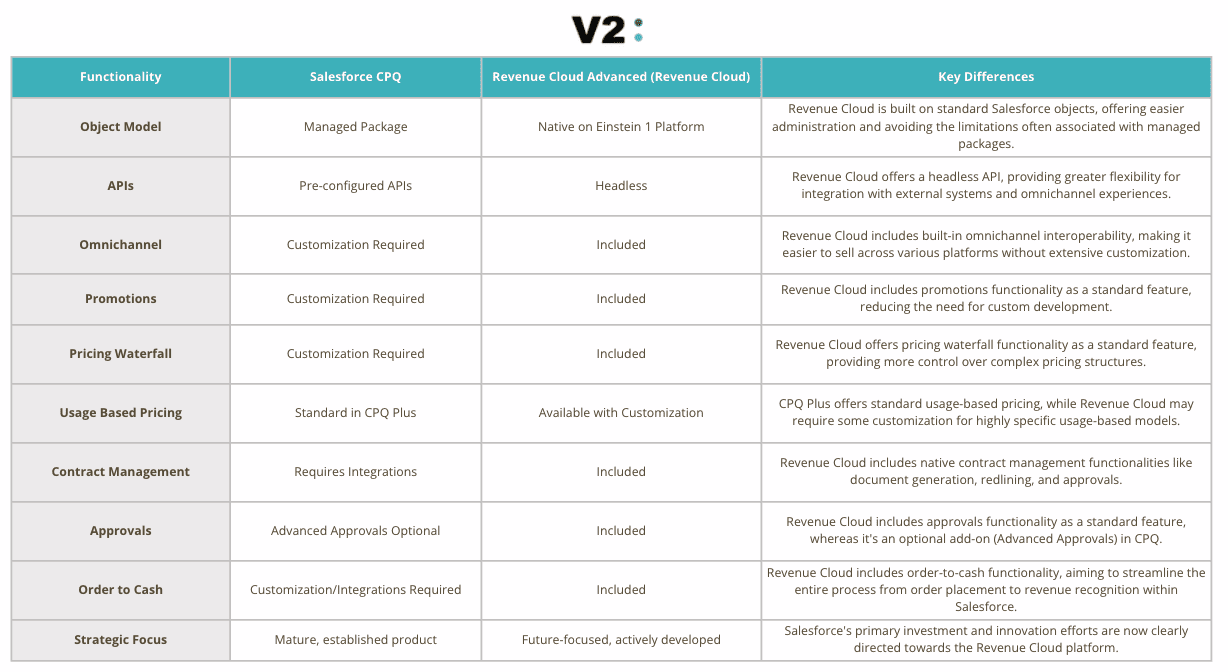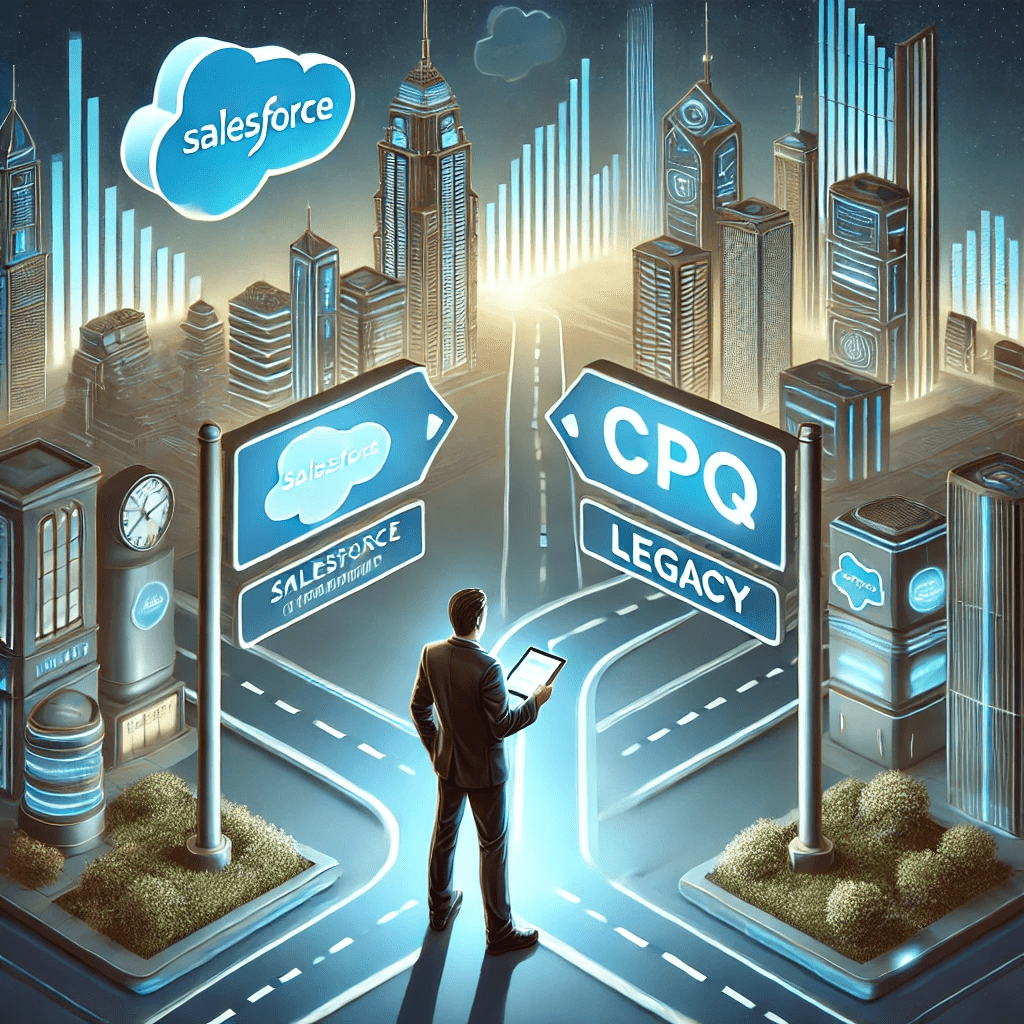Why Salesforce Revenue Cloud
Is the Future of Revenue Management
The Salesforce ecosystem has been buzzing over the last few months, and the confirmation is finally here: Salesforce CPQ is officially in an “end of sale” period. For many of our clients, this news brings a mix of curiosity and concern, especially those who’ve relied on CPQ to streamline their quoting and pricing for years. In essence, Salesforce will no longer sell new licenses for the CPQ product, but existing customers can continue using it with the same level of support and will be able to renew their subscriptions.
This isn’t just a minor product update; it’s a strategic pivot by Salesforce, signaling a significant shift in their revenue management offerings. For those of us who’ve been following Salesforce for a while, this news wasn’t entirely unexpected, particularly given the relative quiet on the CPQ innovation front recently. It’s a moment that prompts us, as your trusted technology consultants, to delve deeper into what this means for your business and what the future holds.
Let’s not forget the origins of Salesforce CPQ. It wasn’t always a Salesforce native product. Back in late 2015, Salesforce made a strategic acquisition, bringing Steelbrick CPQ into their fold for a substantial $360 million. Steelbrick had already established itself as a leading CPQ solution, and its integration into the Salesforce platform quickly made it a go-to tool for organizations needing to handle complex product configurations and pricing. Now, almost a decade later, we’re seeing another evolution in Salesforce’s approach.

The big question on everyone’s mind: what does this “end of sale” really tell us about the future of Salesforce’s CPQ-type product strategy? The overwhelming consensus points towards Salesforce Revenue Cloud, which was initially introduced as Revenue Lifecycle Management (RLM) and briefly known as Revenue Cloud Advanced. The renewed interest in Revenue Cloud is palpable, and for good reason. It appears to be the heir apparent, designed to take center stage in Salesforce’s revenue management ecosystem. Let’s unpack this further.
The Implications of Salesforce CPQ’s “End of Sale”
First and foremost, it’s crucial to understand the specifics of this announcement. When Salesforce confirms an “end of sale,” it means they will cease offering new licenses of the CPQ product to new customers . This is a key distinction from an “end of life” announcement. Existing Salesforce CPQ customers are not being forced off the platform immediately. They will continue to receive technical support and can renew their current subscriptions . This provides a degree of stability for current users, but it also necessitates a careful consideration of long-term strategy.
The rationale behind this decision likely stems from Salesforce’s strategic focus on its newer Revenue Cloud offerings. The lack of significant updates to Salesforce CPQ over the past couple of years strongly suggests a strategic deprioritization. As technology advances and business models become more intricate, Salesforce likely recognized the need for a more modern, scalable, and deeply integrated solution built on its core platform, rather than relying on a standalone managed package.
For organizations currently leveraging Salesforce CPQ, the immediate impact is manageable. Your day-to-day operations shouldn’t be disrupted, and you can still count on Salesforce for support and renewals. However, a potential limitation arises for growing organizations that might need to add more CPQ users, as purchasing additional licenses is likely to be restricted. Looking further down the line, some experts speculate a potential “slow and painful decline” for CPQ. This could manifest in various ways, such as integrations with other systems becoming less reliable due to a lack of updates, bug fixes taking longer to implement, and a potential decrease in the quality or responsiveness of technical support for an aging product. While this isn’t an immediate crisis, it’s a clear signal for existing CPQ customers to start evaluating their future options for revenue management. Proactive planning is key to mitigating potential disruptions and ensuring continued operational efficiency.
The Rise of Salesforce Revenue Cloud: Beyond Traditional CPQ
So, if Salesforce CPQ is no longer the go-to for new implementations, what is? The answer is unequivocally Salesforce Revenue Cloud. Initially launched as Revenue Lifecycle Management (RLM) in March 2024, it briefly transitioned to Revenue Cloud Advanced before settling on the name Salesforce Revenue Cloud. This platform represents a significant leap beyond the traditional boundaries of CPQ, offering a comprehensive suite of features designed to manage the entire revenue lifecycle from initial customer engagement to final payment and beyond.

At its core, Revenue Cloud provides robust Product Catalog Management, allowing for centralized control over your product portfolio, including attributes, classifications, and rules. This is akin to the Enterprise Product Catalog found in Industries CPQ 1. Salesforce Pricing capabilities enable the creation of customized price adjustment schedules and discounts, ensuring accurate net price calculations with real-time visibility and waterfall testing. The intuitive Product Configurator simplifies the selection of options for both simple and complex products. Quote and Order Capture facilitates the creation of quotes and the capture of orders across various channels, supporting subscription lifecycles and integrating seamlessly with other Salesforce products. Asset Lifecycle Management provides valuable insights into customer assets and manages their lifecycle through amendments and renewals.
A significant advantage of Revenue Cloud over standalone CPQ is the native inclusion of Contract Lifecycle Management (CLM), offering features like document generation and approvals without the need for external integrations. Revenue Cloud also incorporates comprehensive Billing capabilities, automating processes for subscriptions and recurring revenue. For organizations with complex order fulfillment needs, Dynamic Revenue Orchestration (DRO) allows for the management of intricate processes. Built on the cutting-edge Einstein 1 Platform, Revenue Cloud features an API-First Architecture with a headless API for easier integration with various systems. Furthermore, it leverages the power of AI Capabilities through Einstein AI for tasks such as pricing optimization, contract analysis, and potentially guided selling.
The benefits of adopting Revenue Cloud are numerous. It provides a unified platform that seamlessly integrates sales, finance, and legal processes, establishing a single source of truth for all revenue-related data. Its native architecture on the Einstein 1 Platform translates to improved scalability and performance compared to CPQ’s managed package structure. Revenue Cloud enables enhanced automation across the entire revenue lifecycle, significantly reducing manual effort and the potential for errors. The platform’s API-first and headless architecture facilitates better omnichannel interoperability, a crucial aspect in today’s multi-channel business environment. By streamlining and automating key processes, Revenue Cloud contributes to faster sales cycles and improved customer satisfaction , ultimately leading to the potential for increased revenue.
Revenue Cloud as the Strategic Successor: What Salesforce is Saying
Salesforce has been quite clear in positioning Revenue Cloud as the strategic successor to CPQ for new implementations. A Salesforce spokesperson confirmed that Revenue Cloud Advanced and Billing are the recommended alternatives for new customers. This highlights Salesforce’s commitment to ensuring that the new Revenue Cloud offerings not only match but exceed the functionality of the previous CPQ product. Official news releases from Salesforce emphasize Revenue Cloud as a transformative solution for managing the entire revenue lifecycle, connecting the often-siloed quote-to-cash process. Sessions at Dreamforce 2024 actively promoted Revenue Cloud as a platform that goes “Beyond CPQ” to drive revenue success. Even the Salesforce CPQ webpage now directs users to explore Revenue Cloud for streamlining their quote-to-cash processes. These consistent messages across various official channels leave little room for doubt about Salesforce’s strategic direction in this critical area.
Multiple sources indicate that Revenue Cloud offers at least feature parity with Salesforce CPQ, while also natively incorporating Billing and CLM functionalities. It’s often described as a natural evolution of CPQ, seamlessly integrating its core capabilities into a more comprehensive and unified solution. Revenue Cloud is also designed to address some of the limitations inherent in traditional CPQ systems, such as scalability for handling very large quotes and managing complex subscription-based business models. This suggests that Revenue Cloud isn’t just a replacement but a significant upgrade, offering enhanced capabilities that extend beyond the traditional scope of CPQ. The inclusion of advanced features like Dynamic Revenue Orchestration (DRO) and deeper AI integration further solidifies its position as a major step forward in revenue management technology.
A Closer Look: Salesforce CPQ vs. Revenue Cloud Advanced
To better understand the shift, let’s compare some key aspects of Salesforce CPQ and Revenue Cloud Advanced (now simply Revenue Cloud):

This comparison highlights the strategic evolution from a managed package (CPQ) to a native platform solution (Revenue Cloud). Building on the core Salesforce platform allows for tighter integration with other Salesforce clouds, potentially leading to enhanced performance and scalability .
What About Other Salesforce CPQ Options?
It’s important to touch upon Salesforce Industries CPQ (formerly Vlocity CPQ), which is specifically designed for industry verticals like Communications, Media, and Energy & Utilities. Following Salesforce’s acquisition of Vlocity, the future strategy for Industries CPQ in relation to the broader Revenue Cloud focus remains somewhat unclear. Organizations in these specific industries should closely monitor Salesforce’s announcements and roadmaps for this product line.
While standard Sales Cloud does offer basic quoting capabilities, these are generally insufficient for organizations with complex CPQ requirements . There are also alternative CPQ solutions available on the Salesforce AppExchange, such as Kugamon CPQ, which is often positioned for the SMB and mid-market segments. However, for comprehensive revenue lifecycle management within the Salesforce ecosystem, Revenue Cloud is emerging as the primary strategic direction.
Deconstructing Salesforce Revenue Cloud: A Consultant’s Perspective
From our viewpoint as technology consultants, understanding the core components of Revenue Cloud is essential for advising our clients effectively. Revenue Cloud can be seen as a suite of interconnected modules, including:
-
-
- Product Catalog and Pricing: The foundation for managing product information and pricing strategies.
- Transaction Management (including CPQ): This incorporates the core CPQ functionalities for configuring, pricing, and quoting, but within the broader Revenue Cloud context.
- Contract Lifecycle Management (CLM): Native capabilities for managing the entire contract process.
- Order-to-Cash (including Order Management/Dynamic Revenue Orchestration): Managing the flow from order placement through fulfillment and payment.
- Billing: Automating invoicing and managing subscriptions and recurring revenue.
-
Revenue Cloud can also integrate with other Salesforce offerings like Partner Relationship Management (PRM) and Revenue Analytics to provide a more holistic view of the revenue ecosystem.
While the standalone CPQ product is in “end of sale,” its core functionality is now a key part of the Transaction Management component within Revenue Cloud . This signifies that Salesforce isn’t abandoning the crucial CPQ capabilities but rather evolving them into a more comprehensive platform that addresses the entire revenue lifecycle . Therefore, the “end of sale” of standalone CPQ shouldn’t be seen as a reason to avoid investing in Revenue Cloud. In fact, for new customers requiring CPQ-like functionality, Revenue Cloud is the clear path forward. The native platform architecture and the broader feature set of Revenue Cloud offer significant long-term benefits for organizations looking to optimize their revenue operations .
Industry and Community Perspectives: What the Experts are Saying
The general consensus among industry experts aligns with our analysis: Revenue Cloud is the future of Salesforce’s revenue management offerings . Some even suggest that CPQ is effectively nearing its end . While some alternative CPQ vendors position their solutions as superior , the trend within the Salesforce ecosystem is clearly towards Revenue Cloud. Many of our consultants, and other Industry folks we’ve chatted with recently, recommend Revenue Cloud Advanced as the best investment for the future. The focus on the entire revenue lifecycle, the unified nature of the platform, and the integration of AI capabilities are frequently cited as key advantages.
However, the Salesforce community on platforms like Reddit presents a more nuanced view . While there’s agreement that CPQ is becoming legacy and Revenue Cloud, being built on the core platform, offers a “better” architecture, concerns exist. Some users point out that Revenue Cloud is still relatively new and might not be as robust as expected, with potential bugs and a lack of comprehensive documentation. The absence of a direct migration path from CPQ and the potential for extra costs associated with Revenue Cloud licensing are also points of discussion. Some community members suggest waiting to see how Revenue Cloud matures before making a move, while others highlight the potentially high cost for small to medium-sized businesses.
Navigating the Transition: Our Recommendations
As your technology consultants, we believe that understanding the implications of Salesforce CPQ’s “end of sale” and the rise of Revenue Cloud is crucial for making informed decisions about your revenue strategy.
Our key recommendations are:
-
- For New Customers: If you’re looking to implement CPQ-like capabilities, Salesforce Revenue Cloud is the recommended path forward. Carefully evaluate your specific business needs and the current maturity of the Revenue Cloud platform to ensure it aligns with your requirements and budget.
- For Existing CPQ Customers: It’s time to start planning your long-term strategy . This may involve a future migration to Revenue Cloud or exploring alternative solutions as Salesforce CPQ’s development stagnates. Weigh the costs and effort of migration against the potential risks of staying on a system that may become increasingly outdated and difficult to integrate.
- For Existing Revenue Cloud Customers: You’re likely well-positioned for the future. Continue to leverage the platform and stay informed about new features and updates from Salesforce.
The Salesforce ecosystem is undergoing a significant evolution in its approach to revenue management. The “end of sale” of CPQ is a clear indicator of this shift, and businesses need to adapt their strategies accordingly to ensure they have the right tools to effectively manage their revenue processes in the long term.
Building Trust Starts With A Conversation.
Do you have questions about how the Salesforce CPQ “end of sale” impacts your business? Are you considering a move to Salesforce Revenue Cloud and want to understand if it’s the right fit for your organization? Our team of experienced Salesforce consultants is here to help. We can provide personalized guidance to help you navigate these changes, understand the possibilities with Revenue Cloud, and determine the best solutions to meet your specific use cases and challenges. Please don’t hesitate to reach out – we’d love to partner with you on your revenue management journey.


